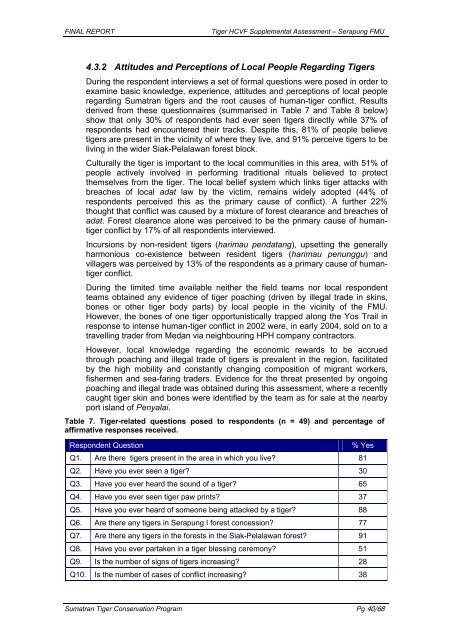A Supplemental HCVF Assessment on the Sumatran Tiger ...
A Supplemental HCVF Assessment on the Sumatran Tiger ...
A Supplemental HCVF Assessment on the Sumatran Tiger ...
Create successful ePaper yourself
Turn your PDF publications into a flip-book with our unique Google optimized e-Paper software.
FINAL REPORT <strong>Tiger</strong> <str<strong>on</strong>g>HCVF</str<strong>on</strong>g> <str<strong>on</strong>g>Supplemental</str<strong>on</strong>g> <str<strong>on</strong>g>Assessment</str<strong>on</strong>g> – Serapung FMU<br />
4.3.2 Attitudes and Percepti<strong>on</strong>s of Local People Regarding <strong>Tiger</strong>s<br />
During <strong>the</strong> resp<strong>on</strong>dent interviews a set of formal questi<strong>on</strong>s were posed in order to<br />
examine basic knowledge, experience, attitudes and percepti<strong>on</strong>s of local people<br />
regarding <strong>Sumatran</strong> tigers and <strong>the</strong> root causes of human-tiger c<strong>on</strong>flict. Results<br />
derived from <strong>the</strong>se questi<strong>on</strong>naires (summarised in Table 7 and Table 8 below)<br />
show that <strong>on</strong>ly 30% of resp<strong>on</strong>dents had ever seen tigers directly while 37% of<br />
resp<strong>on</strong>dents had encountered <strong>the</strong>ir tracks. Despite this, 81% of people believe<br />
tigers are present in <strong>the</strong> vicinity of where <strong>the</strong>y live, and 91% perceive tigers to be<br />
living in <strong>the</strong> wider Siak-Pelalawan forest block.<br />
Culturally <strong>the</strong> tiger is important to <strong>the</strong> local communities in this area, with 51% of<br />
people actively involved in performing traditi<strong>on</strong>al rituals believed to protect<br />
<strong>the</strong>mselves from <strong>the</strong> tiger. The local belief system which links tiger attacks with<br />
breaches of local adat law by <strong>the</strong> victim, remains widely adopted (44% of<br />
resp<strong>on</strong>dents perceived this as <strong>the</strong> primary cause of c<strong>on</strong>flict). A fur<strong>the</strong>r 22%<br />
thought that c<strong>on</strong>flict was caused by a mixture of forest clearance and breaches of<br />
adat. Forest clearance al<strong>on</strong>e was perceived to be <strong>the</strong> primary cause of humantiger<br />
c<strong>on</strong>flict by 17% of all resp<strong>on</strong>dents interviewed.<br />
Incursi<strong>on</strong>s by n<strong>on</strong>-resident tigers (harimau pendatang), upsetting <strong>the</strong> generally<br />
harm<strong>on</strong>ious co-existence between resident tigers (harimau penunggu) and<br />
villagers was perceived by 13% of <strong>the</strong> resp<strong>on</strong>dents as a primary cause of humantiger<br />
c<strong>on</strong>flict.<br />
During <strong>the</strong> limited time available nei<strong>the</strong>r <strong>the</strong> field teams nor local resp<strong>on</strong>dent<br />
teams obtained any evidence of tiger poaching (driven by illegal trade in skins,<br />
b<strong>on</strong>es or o<strong>the</strong>r tiger body parts) by local people in <strong>the</strong> vicinity of <strong>the</strong> FMU.<br />
However, <strong>the</strong> b<strong>on</strong>es of <strong>on</strong>e tiger opportunistically trapped al<strong>on</strong>g <strong>the</strong> Yos Trail in<br />
resp<strong>on</strong>se to intense human-tiger c<strong>on</strong>flict in 2002 were, in early 2004, sold <strong>on</strong> to a<br />
travelling trader from Medan via neighbouring HPH company c<strong>on</strong>tractors.<br />
However, local knowledge regarding <strong>the</strong> ec<strong>on</strong>omic rewards to be accrued<br />
through poaching and illegal trade of tigers is prevalent in <strong>the</strong> regi<strong>on</strong>, facilitated<br />
by <strong>the</strong> high mobility and c<strong>on</strong>stantly changing compositi<strong>on</strong> of migrant workers,<br />
fishermen and sea-faring traders. Evidence for <strong>the</strong> threat presented by <strong>on</strong>going<br />
poaching and illegal trade was obtained during this assessment, where a recently<br />
caught tiger skin and b<strong>on</strong>es were identified by <strong>the</strong> team as for sale at <strong>the</strong> nearby<br />
port island of Penyalai.<br />
Table 7. <strong>Tiger</strong>-related questi<strong>on</strong>s posed to resp<strong>on</strong>dents (n = 49) and percentage of<br />
affirmative resp<strong>on</strong>ses received.<br />
Resp<strong>on</strong>dent Questi<strong>on</strong> % Yes<br />
Q1. Are <strong>the</strong>re tigers present in <strong>the</strong> area in which you live? 81<br />
Q2. Have you ever seen a tiger? 30<br />
Q3. Have you ever heard <strong>the</strong> sound of a tiger? 65<br />
Q4. Have you ever seen tiger paw prints? 37<br />
Q5. Have you ever heard of some<strong>on</strong>e being attacked by a tiger? 88<br />
Q6. Are <strong>the</strong>re any tigers in Serapung I forest c<strong>on</strong>cessi<strong>on</strong>? 77<br />
Q7. Are <strong>the</strong>re any tigers in <strong>the</strong> forests in <strong>the</strong> Siak-Pelalawan forest? 91<br />
Q8. Have you ever partaken in a tiger blessing cerem<strong>on</strong>y? 51<br />
Q9. Is <strong>the</strong> number of signs of tigers increasing? 28<br />
Q10. Is <strong>the</strong> number of cases of c<strong>on</strong>flict increasing? 38<br />
<strong>Sumatran</strong> <strong>Tiger</strong> C<strong>on</strong>servati<strong>on</strong> Program Pg 40/68

















